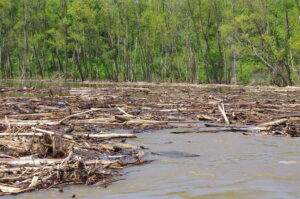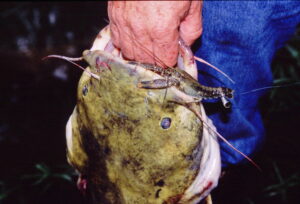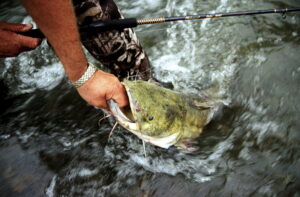When fishing floodwaters for flatheads, bank fishermen often find
themselves battling big catfish in extremely shallow water.
Floodwater Flatheads
by Keith “Catfish” Sutton
When heavy spring rains cause rivers to rise, flathead catfish go on a gluttonous feeding binge. Smart anglers go fishing then.
Flathead catfish differ from other catfish in many ways. For example, flatheads aren’t very mobile. During any given year, they usually roam no more than a mile from the single unit of cover they call home. Blue and channel catfish, on the other hand, often travel great distances—sometimes hundreds of miles.
Flatheads also are solitary fish, and aggressive to others of their own kind, unlike blues and channels, which frequently live in small groups or loose schools. A prime piece of flathead real estate—usually a log pile or other protected site where woody debris has accumulated—rarely contains more than one adult fish.

I mention these two characteristics in particular because they affect the catch rates of many catfish anglers, especially those of us who enjoy fishing from shore. If you fish primarily from the bank and not a boat (some studies indicate up to 70 percent of catfishermen do), you must depend on the enticing movement, taste and smell of a live baitfish (the best flathead attractor) to draw your quarry in. The problem is, flatheads don’t move very much, and when they do, they roam alone. An angler working a lake cover or the pool of a river from the bank is lucky to catch one decent flathead during several nights of fishing.
There is a time, however, when flatheads abandon these typical patterns. For example, in spring, when heavy rains cause rivers and lakes to rise and become muddy, flatheads go on a run-and-gun feeding spree. Some anglers believe they are hungry after several winter months on lean rations, and the sudden influx of food animals washed into the water by warm rain stimulates feeding activity. Others believe the spawning urge draws the fish together, and they feed ravenously to fatten up before the austerity of egg-laying and nesting. Whatever the case may be, this is a boon time for flathead fans. No better situation exists for catching flatheads in numbers.

I have been an ardent flathead catfish angler for more than 50 years now. If you rate a fishing trip by the number of fish caught, my best for flatheads was on the lower Mississippi River on a spring night almost 30 years ago under conditions such as those I just described. The river was well above flood stage and muddy enough to track a raccoon across. Fishing a steep, timbered bank of revetment, two friends and I boated more than 150 flatheads that weighed 2 to 25 pounds.
Nights such as that are unusual, even in high water, but if you use proper techniques, high-rise flatheads will provide exciting action. Safety considerations must be foremost on your mind, of course. And for that reason, bank fishing is actually the best choice in this situation. I prefer fishing the points on both sides of a tributary mouth where I can work a broad swath of water, but areas above and below log jams, wing dikes and bridges also have proven productive.
3 Hotspots for Spring Flatheads
Lake Conway, Arkansas: Few bodies of water in the United States churn out the number of monster flatheads produced by this 6,700-acre Arkansas Game & Fish Commission lake just west of Little Rock. Numerous 50-pound-plus fish have been caught by local anglers during the past year.
Alabama River, Alabama: From Montgomery to Mobile, anglers will find more than 300 miles of prime flathead water in this beautiful mid-sized river. Fishing live baitfish around wood cover will coax bites from some true behemoths, including some exceeding 40 pounds.
Pomona Lake, Kansas: This 4,000-acre lake 25 miles south of Topeka remains relatively unknown outside a circle of local cat fans, but each year it produces scores of flatheads from 40 to 80 pounds and more.
Leave your rod holders home. This is active fishing with the rod in your hand. I work the bait 1 to 2 feet beneath an orange-sized float (high-rise flatheads seldom feed deep), casting it upstream as far as possible, then allowing the rig to drift on a fairly tight line. When my rig nears the end of each drift, before it gets snagged near the bank downstream, I reel in, cast upstream again and repeat the process. I work from far to near (in relation to the bank) on successive casts.

Because huge flatheads are possible, maybe even a 100-pounder, I use large sturdy hooks, stout line and a tough rod-and-reel combo. Favored tackle consists of a 10- to 12-foot surf rod for increased casting distance and better rig control, a heavy spinning reel spooled with 50- to 80-pound-test braided line, and an 8/0 octopus hook. I prefer a simple, more snag-free rig with no weight other than the bait itself, due to the large amount of floating debris in the water. And the bait is not always the live fish (sunfish, carp or bullhead) I prefer during other seasons. In flood waters, flatheads feed more indiscriminately, and I often catch them on crawfish, shad guts and large balls of big night crawlers in addition to fish. Night fishing always is best.
Other game plans may work as well or better, and like I always say, experimenting is half the fun of catfishing. Try your own rigs and techniques, but be sure you don’t miss out on this seasonal catfishing bonanza. Spring is one of the best seasons to hook and land numerous flatheads, including some trophy-sized fish.





